

Dykestowatchoutfor.com » Blog Archive » The Rule. This is Cathy writing, not Alison, despite what the author tag says.
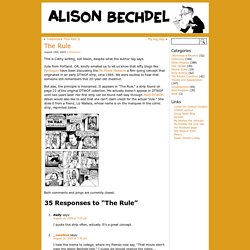
Julie from Portland, OR, kindly emailed us to let us know that lefty blogs like Pandagon have been discussing the Mo Movie Measure a film-going concept that originated in an early DTWOF strip, circa 1985. We were excited to hear that someone still remembers this 20-year-old chestnut. But alas, the principle is misnamed. It appears in “The Rule,” a strip found on page 22 of the original DTWOF collection. Mo actually doesn’t appear in DTWOF until two years later. 10 Foods for Sinus Health & 10 Ways to Relieve Infection. The warm, dark environment of the sinuses create the optimal space for infections; learn how to combat and relieve sinus infection and improve your sinus health.

The sinuses are small air pockets in the skull around the eyes, nose, and forehead that are lined with mucus membranes. They moisten the air we breathe in while also catching dust, microbes, and allergens before these can reach the lungs. This warm, moist environment is the perfect breeding ground for bacteria, fungi, and mold, but the body does a good job of removing or destroying the captured bacteria, spores, and cysts before they can begin growing. Problems arise when our mucus membranes are damaged or the mucus becomes too thick to move freely.
When this happens, infections can explode to life in the pockets of your sinuses. The Origins of “Privilege” The idea of “privilege”—that some people benefit from unearned, and largely unacknowledged, advantages, even when those advantages aren’t discriminatory —has a pretty long history.
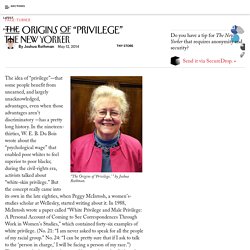
In the nineteen-thirties, W. E. B. Du Bois wrote about the “psychological wage” that enabled poor whites to feel superior to poor blacks; during the civil-rights era, activists talked about “white-skin privilege.” National SEED Project - White Privilege: Unpacking the Invisible Knapsack. White Privilege: Unpacking the Invisible Knapsack Downloadable PDF.
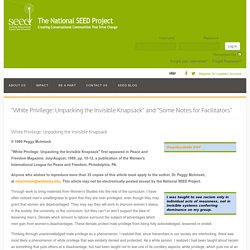
Teaching Tolerance - Diversity, Equity and Justice. Overview: Explores issues of race and white privilege Excerpted from White Anti-Racist Activism: A Personal Roadmap by Jennifer R.

The Origins of “Privilege” Untitled. Avoiding Ableist or Sexist Language Won’t Make Us Less Fun! I found this amazing campaign on a website and decided to share on my facebook wall.
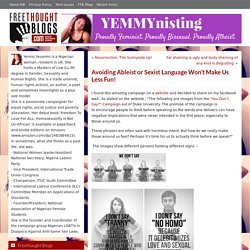
As stated on the website , “The following are images from the “You Don’t Say?” Campaign out of Duke University. The premise of the campaign is to encourage people to think before speaking as the words one delivers can have negative implications that were never intended in the first place, especially to those around us. KIMCHI CUDDLES.
White Privilege Conference. Hey, Smug White People: You (Yes, You) Are a Racist, Too. If there’s anything our fraught national dialogue on race has taught us, it's that there are no racists in this country.
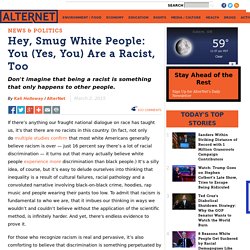
(In fact, not only do multiple studies confirm that most white Americans generally believe racism is over — just 16 percent say there’s a lot of racial discrimination — it turns out that many actually believe white people experience more discrimination than black people.) What is Change From Within? Change From Within is a space with two purposes or goals.
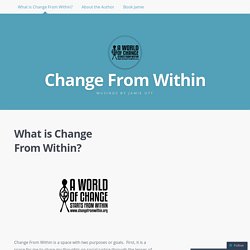
First, it is a space for me to share my thoughts on social justice through the lenses of community, race, religion, gender, sexual orientation, ability, class, and hopefully much more! In my work as a diversity consultant and professional presenter on issues of diversity, I encourage people to see introspection and relationship building as key to making the changes in oneself that inevitably lead to changes in our society and culture: hence the name Change From Within.
Second, it is my hope that my musings will lead others to talk, consider, reflect, and respond! It is my hope that you will take the thoughts and considerations inspired by the blog into your community to discuss with family, friends, acquaintances, Facebook fans, Twitter followers, and so on. You are also welcome to reach out to me via Twitter if you would like to discuss a piece (though there is no guarantee I will respond). Home. 7 reasons why reverse racism doesn't exist. The state of race relations in the U.S., a country where people seem to be under the mistaken belief that we are “post-racial,” is dire.
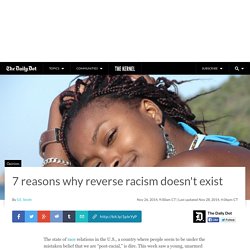
This week saw a young, unarmed black man killed by the NYPD in a stairwell, and a refusal to indict from a Ferguson grand jury. Responses to these events from those concerned about systemic discrimination against people of color also saw the revival of a familiar battle cry among my fellow honkies: “Reverse racism!” Accusations of “reverse racism” are dragged out in many cases when people of color and nonwhite people speak out, sometimes passionately, about racial issues. In Texas, for example, a teacher was recently forced out of her job after a profanity-laced tweet from her private account, in which she referred to white people as “crackers.” Make no mistake: The district’s pressure wasn’t about the use of some four letter words.
#Breaking: Reverse racism doesn’t exist. When White Feminists Respond to Anti-Racism Like Men Respond to Feminism. Black hair faqs (10 things non-blacks want to know) Zoe samudzi's social stories. My Feminism Looks Like… Zoe Samudzi. 1.

Can you tell me a little about yourself? My name is Zoe Samudzi, I’m a 22 year old first generation American of Zimbabwean descent. I’m an academic, and I currently work on a research project that’s seeking to create culturally-competent (i.e. context and identity-specific) HIV interventions for trans women. I no longer identify as a feminist, but as a womanist. I’ve come to the point where I’m no longer going to insist upon inclusion in a set of gender politics that actively antagonizes black women/women of color and trans women and sex workers and excludes many others when I could be contributing to an epistemology that is rooted in my ideological oppression and lived experiences as a black woman. 2. 5 Ways Taylor Swift Exemplifies White Feminism – And Why That's a Problem. Make no mistake: I love Taylor Swift. “I Knew You Were Trouble” is one of my favorite shower songs, I’ve cried incessantly to “All Too Well” after a breakup (and, um, every time I hear it), and I could kick your ass at “We Are Never, Ever Getting Back Together” karaoke.
By far, she’s my problematic fave. But goddamn, is she ever problematic. And as much as I appreciate a pop artist that I love donning the feminist label, I really hate when they do so in the name of the special brand of fucked-up anti-oppression work known as White Feminism. Why Saying 'It's My Choice' Doesn't Necessarily Make Your Choice Feminist. Panel 1 Character: (Wearing traditionally feminine attire, with hands on hips) I can wear lipstick and still be a feminist! It’s my choice, and that’s feminist in itself! Text: Given the advent of “choice feminism,” this is a really common refrain amongst feminists. Dear Christina Fallin. This White Feminist Loved Her Dreadlocks – Here's Why She Cut Them Off.
Here Are 4 Ways to Navigate Whiteness and Feminism – Without Being a White Feminist (TM) Womanism. Unification is a key cornerstone of womanist ideology. Womanism is a social theory based on the history and everyday experiences of women of color, especially black women. It seeks, according to womanist scholar Layli Maparyan (Phillips), to "restore the balance between people and the environment/nature and reconcil[e] human life with the spiritual dimension".[1] Writer Alice Walker coined the term womanist in a short story, "Coming Apart", in 1979.[3][4] Since Walker's initial use, the term has evolved to envelop varied, and often opposing interpretations of conceptions such as feminism, men, and blackness.[5] Theory[edit] The Black Feminist's Guide to the Racist Sh*t That Too Many White Feminists Say. National Women's Law Center. Womanism. Closing_the_wage_gap_is_crucial_for_woc_and_their_families_2015.pdf. Closing the Wage Gap is Crucial for Women of Color and Their Families.
The Black Feminist's Guide to the Racist Sh*t That Too Many White Feminists Say. A chilling reminder that Black lives matter less to police: “I won’t soon forget the sound of people screaming from pepper spray”